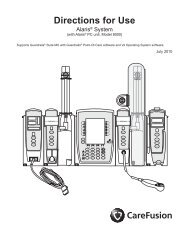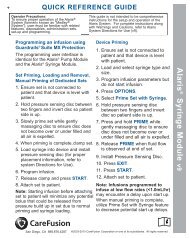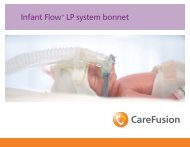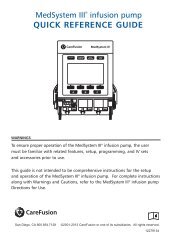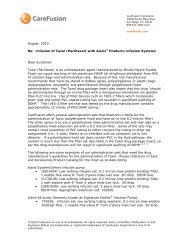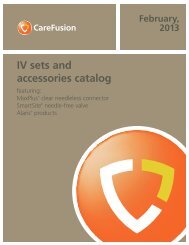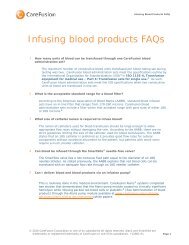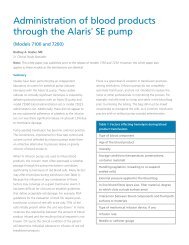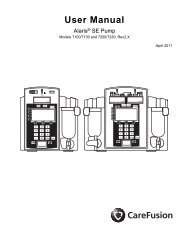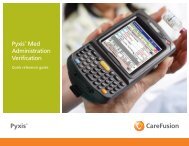Infant Flow® LP system headgear - CareFusion
Infant Flow® LP system headgear - CareFusion
Infant Flow® LP system headgear - CareFusion
Create successful ePaper yourself
Turn your PDF publications into a flip-book with our unique Google optimized e-Paper software.
<strong>Infant</strong> Flow ®<br />
<strong>LP</strong> <strong>system</strong> <strong>headgear</strong>
Prepare <strong>Infant</strong> Flow ®<br />
<strong>LP</strong> SiPAP driver ...............1<br />
<strong>Infant</strong> Flow <strong>LP</strong> components ............................2<br />
Generator assembly components ...................3<br />
Low pressure generator .................................4<br />
Nasal prongs ..................................................5<br />
Nasal masks ...................................................6<br />
Nasal prongs and mask sizing ........................7<br />
Headgear sizing .............................................8<br />
Generator assembly application .....................9<br />
Headgear application ............................9-11<br />
Check for proper <strong>headgear</strong> placement .....12<br />
Incorrect <strong>headgear</strong> placement .............13-14<br />
Attach interface to generator ...................15<br />
Remove the support cradle ......................16<br />
Apply support cradle to <strong>headgear</strong> ............17<br />
Align generator assembly .........................18<br />
Table of contents<br />
i<br />
Secure the locking strap ...........................19<br />
Attach side straps to generator ................20<br />
Final check of generator assembly ................21<br />
Check for correct <strong>headgear</strong> placement .....21<br />
Check placement of exhalation tube ........22<br />
Check for proper nasal prong position .....23<br />
Incorrect nasal prong position ..................24<br />
Verify proper mask placement ..................25<br />
Incorrect mask placement ........................26<br />
Incorrect mask size—too small .................27<br />
Incorrect mask size—too large .................28<br />
Warnings and cautions ................................29<br />
Application tips ............................................30<br />
Inspect the <strong>system</strong> .......................................31<br />
Notes ......................................................32-33
Prepare <strong>Infant</strong> Flow <strong>LP</strong> SiPAP driver<br />
1. Attach the infant circuit to humidifier<br />
and nCPAP driver.<br />
2. Attach generator to the circuit.<br />
3. Perform oxygen sensor calibration<br />
and user verification.<br />
4. Enter desired settings.<br />
1<br />
NCPAP/<br />
Pres Low<br />
L/min<br />
14<br />
50<br />
60<br />
70<br />
40<br />
80<br />
12<br />
30<br />
90<br />
10<br />
21<br />
8<br />
100<br />
6<br />
4<br />
2<br />
<strong>Infant</strong> Flow<br />
SiPAP<br />
XDCR<br />
P PROX<br />
Pres High<br />
L/min<br />
5<br />
4<br />
3<br />
2<br />
1<br />
3 4<br />
1<br />
2
<strong>Infant</strong> Flow <strong>LP</strong> components<br />
A. Prongs and masks<br />
B. Generator<br />
C. Bonnet sizing guide<br />
D. Mask/prong sizing guide<br />
E. Headgear<br />
F. Bonnet<br />
D<br />
A<br />
B<br />
2<br />
E<br />
F<br />
C
Generator assembly components<br />
A. Exhalation tube<br />
B. Securing strap<br />
C. Generator receiver<br />
D. Fixation tab<br />
E. Mask/prong<br />
attachment base<br />
F. Support cradle<br />
G. Pressure and drive lines<br />
C<br />
D<br />
E<br />
3<br />
B<br />
F<br />
A<br />
G
Low pressure generator<br />
• Lower drive pressure<br />
– Prevents pressure backup into the<br />
water auto-feed <strong>system</strong><br />
• Pressure relief valve<br />
4<br />
Pressure relief valve
Nasal prongs<br />
Anatomically designed<br />
A. Flared tip<br />
B. Flexible bellows<br />
C. Base<br />
D. Size indicator<br />
E. Key<br />
5<br />
A<br />
B<br />
C<br />
D<br />
E<br />
A<br />
B<br />
C<br />
D
Nasal mask<br />
Anatomically designed<br />
A. Nasal bridge cushion<br />
B. Contour shape<br />
C. Key<br />
D. Flexible bellow<br />
E. Assessment window<br />
F. Size indicator<br />
6<br />
A<br />
B<br />
C<br />
D<br />
E<br />
E<br />
D<br />
F
Nasal prongs and mask sizing<br />
• Use sizing guide to determine appropriate<br />
mask or prong size<br />
• Nasal prongs: Choose dots that fill the<br />
nare space<br />
• If between sizes, choose the larger size<br />
• Nasal masks: Choose the triangle that fits<br />
over the nose<br />
7
Headgear sizing<br />
Measure the circumference of the infant’s head; from crown at back of head to brow line<br />
(in centimeters).<br />
8
Generator assembly application<br />
Headgear application<br />
1. Align <strong>headgear</strong> with the midline of face.<br />
2. Align bottom of the <strong>headgear</strong> with the<br />
nape of neck.<br />
9<br />
1.<br />
2
Headgear application (continued)<br />
3. Place #1 strap just above brow line.<br />
Note: Straps are labeled 1, 2, 3.<br />
4. Place #2 strap midline over strap #1.<br />
10<br />
3.<br />
4.
Headgear application (continued)<br />
5. Place #3 strap on top of #1 and<br />
#2 straps.<br />
Note: Strap should be snug—do<br />
not overtighten.<br />
6. Fold #2 strap up and over #3<br />
strap; secure to top strap.<br />
11<br />
5.<br />
6.
Check for proper <strong>headgear</strong> placement<br />
• Back of <strong>headgear</strong> rests on nape of neck<br />
• Forehead straps placed on brow line<br />
12
Incorrect <strong>headgear</strong> placement<br />
• Horizontal strap rests close to eye<br />
• Forehead strap is too far above the<br />
brow line<br />
13
Incorrect <strong>headgear</strong> placement (continued)<br />
• Above the nape of the neck, creates a<br />
fold/bulging of <strong>headgear</strong><br />
• Top strap too tight, forehead strap #3<br />
pulled back<br />
14
Attach interface to generator<br />
Align the notch on the prongs/mask to straddle the pressure lines.<br />
1.<br />
3. 4 .<br />
15<br />
2.
Remove the support cradle<br />
1. Expand the collapsible corrugated tubing.<br />
2. Remove the support cradle from the<br />
generator assembly.<br />
16<br />
1.<br />
2.
Apply support cradle to <strong>headgear</strong><br />
1. Apply the support cradle properly<br />
centered on the straps.<br />
2. Secure center tab.<br />
17<br />
1.<br />
2.
Align generator assembly<br />
1. Center the generator and interface over<br />
patient nose and support cradle.<br />
2. Use a gentle rocking motion to insert the<br />
nasal prongs.<br />
3. Place the drive line and pressure line into<br />
the support cradle with the exhalation tube<br />
resting on top.<br />
18<br />
1. 2. 3.
Secure the locking strap<br />
1. Wrap the locking strap over the<br />
exhalation tube and attach to the side<br />
of the support cradle.<br />
2. Position the small slit over the ridge of<br />
the exhalation tube.<br />
19<br />
1.<br />
2.
Attach side straps to generator<br />
1. Wrap the side straps around the<br />
generator tabs.<br />
2. Use the Velcro tip to secure the<br />
strap—loose is better.<br />
3. Use the side straps to adjust tension<br />
on interface—do not over-tighten.<br />
20<br />
1. 2.<br />
3.
Final check of generator assembly<br />
Check for correct <strong>headgear</strong> placement<br />
A. Generator aligned and<br />
centered with nose<br />
B. Side straps properly placed<br />
C. Support cradle tabs secured<br />
to <strong>headgear</strong><br />
Note: Straps should be snug,<br />
but not tight. B<br />
A<br />
21<br />
C
Check placement of exhalation tube<br />
Incorrect Correct<br />
22
Check for proper nasal prong position<br />
• Bellows are visible<br />
• Septum is visible<br />
• Generator assembly has<br />
no contact with skin<br />
23
Incorrect nasal prong position<br />
Too tight, bellows compressed<br />
Prong not in the nare<br />
24
Verify proper mask placement<br />
• Mask covers nasal profile<br />
• Mask rests below the eyes<br />
• Bellows not compressed<br />
• Side strap low on cheek<br />
Note: Do not over-tighten.<br />
25
Incorrect mask placement<br />
• Too much tension applied to one side<br />
• Mask is collapsed<br />
• Nares are not visible<br />
26
Incorrect mask size—too small<br />
• Mask blocks the nares<br />
• Mask unable to cover nose<br />
27
Incorrect mask size—too large<br />
• High on the bridge of the nose<br />
• Up against the eyes<br />
• Rest on the upper lip<br />
28
Warnings and cautions<br />
WARNING:<br />
• Use this product only as directed in the product literature to reduce the risk of nasal irritation,<br />
septal distortion, skin irritation and pressure necrosis<br />
• To be used by a trained practitioner, under the direct supervision of a qualified physician<br />
• Only use the <strong>Infant</strong> Flow <strong>LP</strong> generator with variable flow nCPAP drivers<br />
• Do not over-tighten the fixation straps<br />
29
Application tips<br />
• Select the appropriate size nasal mask to minimize leaks and dead space<br />
• Select the appropriate size nasal prongs; if between sizes, select the larger size<br />
• Application of an incorrectly sized prong, mask, bonnet or <strong>headgear</strong> will affect stability of<br />
the generator<br />
• Adjust the straps to stabilize the generator and maintain a seal at the nose using the least<br />
tension possible<br />
• Consider alternating the use of prong and mask interfaces at set intervals to change pressure<br />
points on the infant’s face<br />
• Continuously monitor patient’s respiratory status<br />
• Cover both ears evenly; ensure the ears are not folded<br />
• Recommend humidification be used with nCPAP <strong>system</strong>s<br />
30
Inspect the <strong>system</strong> at least every three to four hours to:<br />
• Ensure the patient’s eyes are clearly visible and the nares are not blocked, when using masks<br />
• Inspect the fixation device and straps for proper tension and adjust as needed to maintain<br />
a proper fit<br />
• Monitor the patient for gastric insufflation and abdominal distension<br />
• Monitor for excessive condensation in circuit and generator<br />
• Alternate the use of prong and mask interfaces to change pressure points on the<br />
infant’s face<br />
31
Notes<br />
32
Notes<br />
33
WARNING—U.S. Federal Law restricts this device to sale by or on the order of a physician.<br />
<strong>CareFusion</strong><br />
22745 Savi Ranch Parkway<br />
Yorba Linda, CA 92887<br />
800.231.2466 toll-free<br />
714.283.2228 tel<br />
714.283.8493 fax<br />
<strong>CareFusion</strong> Germany 234 GmbH<br />
Leibnizstrasse 7<br />
97204 Hoechberg<br />
Germany<br />
+49 931 4972-0 tel<br />
+49 931 4972-423 fax<br />
carefusion.com<br />
© 2011 <strong>CareFusion</strong> Corporation or one of its subsidiaries. All rights reserved.<br />
<strong>Infant</strong> Flow is a trademark or registered trademark of <strong>CareFusion</strong> Corporation or<br />
one of its subsidiaries. RC2661-01 (1211/5000) L3414 Rev. B



